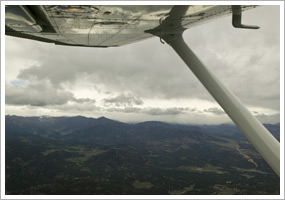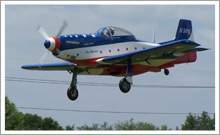| ||||
| | FT News | INSIDE AOPA | TRAINING PRODUCTS | FINAL EXAM | |||
TRAINING TIPsWeather-wary, and wise As summer 2011 approaches after a long, snowy winter, followed by a tornado- and flood-filled spring, pilots have been given more than enough reminders of the importance of weather awareness. Fine-tune your prep by paying special attention to clues that rapid change may be afoot during your expected time aloft. A high dew point that appears in your departure airport’s or destination’s surface aviation weather observation METAR tells you that the atmosphere could become very active. “High dew points correlate well with the probability and severity of thunderstorms,” Thomas A. Horne explained in the March 2003 AOPA Pilot Wx Watch column. “Once thermals, fronts, and other lifting forces go to work on air masses with high dew points, towering cumulus or cumulonimbus clouds can soon follow.” He added this important caution: “Most severe thunderstorms (those with 50-plus-knot surface winds, three-quarter-inch hail, or tornadoes) happen in air masses with dew points above 70 degrees F (21 degrees C).” Even if your last weather briefing still seems fresh, update it just before departure and check the latest radar imagery for any signs of new activity. Good to go? Have your list of frequencies for your personal early warning network handy. It should include Flight Watch and navaids that broadcast hazardous inflight weather advisories (HIWAS). The broadcast of a convective sigmet may be your first alert to weather developments. “When first issued, ATC will broadcast convective sigmets over frequencies used in instrument flight rules operations. VORs with HIWAS capability will broadcast convective sigmets. And, of course, flight service will tell you of any convective sigmets via flight watch (122.0 MHz) or one of its designated flight service frequencies,” Horne wrote in the June 2001 Wx Watch. Under favorable conditions, no adverse weather comes to life more spontaneously, and can develop more quickly, than a thunderstorm or an area of thunderstorms. Just as you scan your instruments for proper heading, altitude, and airspeed, keep checking your early-warning system on weather conditions ahead, and be ready with alternate plans of action for every point along your route. The Air Safety Institute’s WeatherWise: Thunderstorms & ATC online course can give you additional insights about safe approaches to convective activity. YOUR PARTNER IN TRAININGNo person will be more influential in nurturing your desire to fly than your first flight instructor. A good flight instructor will make the flight training process enjoyable while teaching you the intricacies of flight at a pace that is suitable to your schedule and level of learning. Begin your research by reviewing the Flight Training website for helpful articles on selecting an instructor. To find an instructor in your area, go to our searchable database of flight instructors.
Did you know that student pilots who join AOPA are three times more likely to complete their flight training? Membership includes unlimited access to aviation information by phone (800/USA-AOPA, weekdays from 8:30 a.m. to 6 p.m. Eastern time) or from Flight Training Online or AOPA Online. If you're not already a member, join today and get the pilot’s edge. Login information is available online. FLIGHT TRAINING NEWSCommunity can help improve flight trainingAnyone who has ever taken flying lessons can help improve the training process by sharing his or her input in one of a series of regional meetings. The first one kicked off May 24 in Fairfield, N.J., but more sessions are scheduled. Read more >> TSA letter to CFIs ‘voluntary’AOPA is working to help certificated flight instructors in the Baltimore, Md., and Washington, D.C., areas determine how to respond to a “voluntary outreach letter” they may have received from the Transportation Security Administration. The letter reminds active flight instructors of their obligation to comply with training requirements outlined in transportation security regulations. Read more >> New search function on airport directoryWant to enhance your $100 hamburger? Search destinations, events, and attractions near airports on the advanced search page of AOPA Airports, thanks to a new widget powered by OneTankFlights. The widget will persist for about six months as part of a trial arrangement. Read more >> Challenge yourself with an IFR chartPart of the joy of flying is the sense of accomplishment that comes with mastering new skills. For many pilots, the next big challenge beyond the initial checkride is an instrument rating. It’s a different world of flying, one that requires a whole set of new skills—like understanding approach charts (small maps that show the procedures used to land in poor weather). If you’ve ever wondered about life on the other side of the instrument flight rules divide, the Air Safety Institute’s IFR Chart Challenge: ILS Approach is worth checking out. Get started >> Human-powered helicopter lifts offStudents from the University of Maryland successfully test flew a human-powered helicopter on May 12, and its female pilot hovered the aircraft long enough to file for a world aeronautical record. Read more >> Inside AOPAWhy is understanding density altitude important?We know the textbook definition of density altitude: pressure altitude corrected for nonstandard temperature and pressure. But do you know how that translates into your summer afternoon flights? Learn how density altitude affects your aircraft performance and why you should incorporate it into your preflight planning with the latest safety quiz from the Air Safety Institute, sponsored by the AOPA Insurance Agency. Take the quiz >> News from the medical frontThe FAA appears to be centralizing its medication usage policy for medical certification, making it more difficult to obtain timely information on changes to medications, AOPA Director of Medical Certification Gary Crump reports. Read more >> The AOPA Credit Card rewards you for summer travelNothing shakes off the winter doldrums quite like planning a summer vacation. Deciding where to go is the fun part; figuring out how to pay for it not so much. Lucky for AOPA Credit Card holders, their summer vacation can earn them rewards points all along the way. Every purchase made with the card earns one point for every dollar spent, which can be used toward cash, gift cards, and other rewards. Plan on flying to your destination? You can earn two points for every dollar spent on select AOPA products and services and purchases at more than 4,000 participating FBOs. Each time an AOPA Credit Card is used, vital funding is generated to help support AOPA’s expanding campaign to popularize flying and to grow the number of general aviation pilots. Don’t have an AOPA Credit Card? Apply today. TRAINING PRODUCTSUniversal GPS receiver from Sporty’sYou can turn your smartphone or iPad into a GPS with the right application and a universal GPS receiver. This unit, sold by Sporty’s, communicates via Bluetooth with iPad, iPhone, iPod Touch, and many Android, Windows, and Blackberry smartphones and tablets. Use the receiver with ForeFlight, WingX, or other programs. Its rechargeable battery lasts 8.5 hours, and it comes with both a USB cable for charging and a 12-volt car charger. The receiver sells for $99.
Note: Products listed have not been evaluated by ePilot editors unless otherwise noted. AOPA assumes no responsibility for products or services listed or for claims or actions by manufacturers or vendors. FINAL EXAMQuestion: What is the difference between best rate-of-climb speed and best angle-of-climb speed?
Answer: Normally after takeoff a pilot is interested in reaching cruise altitude in the shortest possible time. Only one speed will do that: best rate-of-climb speed, or V Y. This airspeed provides the greatest gain in altitude in the least amount of time. There are other instances, such as obstacles, when a pilot wishes to gain as much altitude as possible in the shortest distance. In this case, a pilot would choose the best angle-of-climb speed, or V X, which provides the greatest gain in altitude in a given distance. The different airspeeds that either limit or result in specific aircraft performance are known as "V" speeds—V for velocity. The different V-speed abbreviations are listed in 14 CFR 1.2. For more information on all the V-speeds and their effect on aircraft safety and performance, read about airspeed on AOPA Online.
Got a question for our technical services staff? Email [email protected] or call the Pilot Information Center, 800/872-2672. Don’t forget the online archive of “Final Exam” questions and answers, searchable by keyword or topic. What’s New OnlineSurviving interview dayThinking about flying for a living but dreading the idea of the interview? Check out this week’s Flight Training blog to learn more about where to look for more information, how to prepare, and whether those interview prep houses are worth it. Read it here. AOPA Career OpportunitiesEver dream of turning your passion for aviation into a career? We’re looking for an application support engineer, member services representative, and applications engineer. To learn more about other AOPA career opportunities, visit AOPA Online. Picture Perfect AVIATION EVENTS & WEATHER To include an event or to search all events in the calendar, visit AOPA Online. For airport details, including FBO fuel prices, see AOPA Airports. Flight Instructor Refresher ClinicsThe next Air Safety Institute Flight Instructor Refresher Clinics are scheduled in Orlando, Fla., Charlotte, N.C., and Columbus, Ohio, June 4 and 5; San Jose, Calif., and Minneapolis, Minn., June 11 and 12; Phoenix, Ariz., and Ashburn, Va., June 25 and 26; and Memphis, Tenn., July 9 and 10. For a complete schedule, see AOPA Online.
Can’t make it in person? Sign up for the CFI Refresher Online. Air Safety Institute Safety SeminarsAir Safety Institute Safety Seminars are scheduled in Oshkosh, Wis., July 27 through 29; and Germantown, Tenn., Wichita, Kan., Fort Worth, Texas, and West Houston, Texas, Sept. 12. Topics vary—for details and a complete schedule, see AOPA Online. | Advertisers Got news? Contact ePilot. Having difficulty using this service? Visit the ePilot Frequently Asked Questions now at AOPA Online or write to [email protected]. |
| Member Tools : Send feedback | ePilot Archive Editorial Team: ePilot Flight Training Editor : Jill W. Tallman | ePilot Editor: Sarah Brown | Contributor: Alton K. Marsh |

 Every experienced pilot can tell a story about encountering surprising weather. But the story is only something to learn from if that pilot did a good job studying the weather before and during the flight.
Every experienced pilot can tell a story about encountering surprising weather. But the story is only something to learn from if that pilot did a good job studying the weather before and during the flight.


